Super User
Why Does My Foot Hurt?
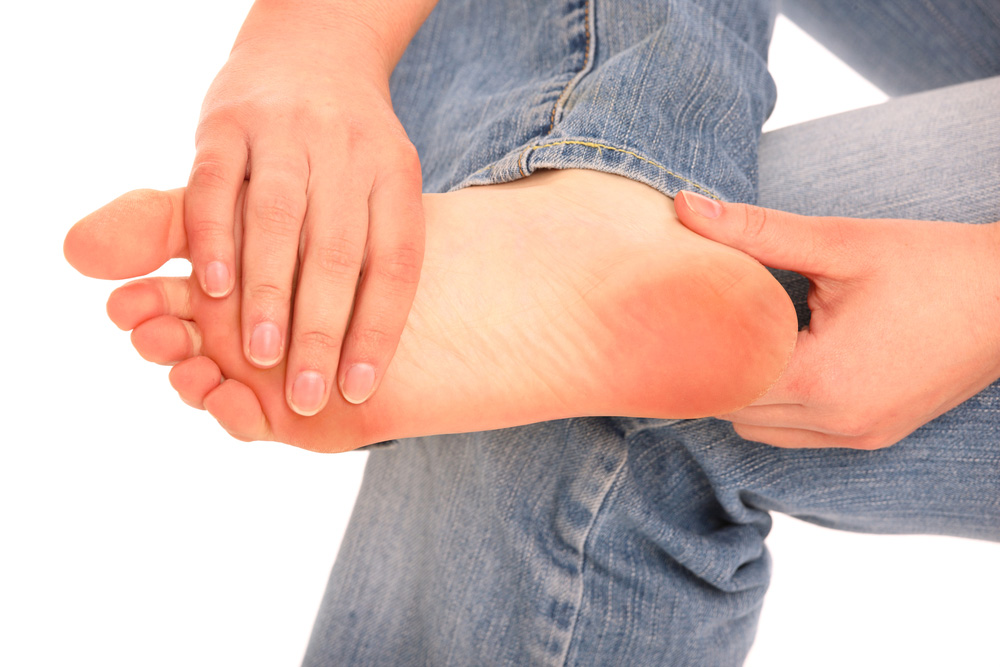 Foot pain is a common symptom for a variety of different foot conditions. The location of pain within the foot may help determine what the cause is. Heel pain is often associated with plantar fasciitis, an inflammation in the band of tissue that runs along the bottom of the foot connecting the heel bone to the toes. Stone bruises are deep bruises on the fat pad of the heel, and heel spurs are irregular bone growths on the bottom of the heel. Both conditions are also causes of foot and heel pain. Pain in the ball of the foot can be caused from conditions like metatarsalgia, Morton’s neuroma, and sesamoiditis. Pain in the arch of the foot may be caused by flat feet, but more commonly, arch pain is caused due to plantar fasciitis. Toe pain can be caused by gout, arthritis, foot deformities like hammertoes or bunions, ingrown toenails, or injuries to the toe such as a strain, sprain, or fracture. To determine the cause of your foot pain and to find the best treatment, consult with a chiropodist today.
Foot pain is a common symptom for a variety of different foot conditions. The location of pain within the foot may help determine what the cause is. Heel pain is often associated with plantar fasciitis, an inflammation in the band of tissue that runs along the bottom of the foot connecting the heel bone to the toes. Stone bruises are deep bruises on the fat pad of the heel, and heel spurs are irregular bone growths on the bottom of the heel. Both conditions are also causes of foot and heel pain. Pain in the ball of the foot can be caused from conditions like metatarsalgia, Morton’s neuroma, and sesamoiditis. Pain in the arch of the foot may be caused by flat feet, but more commonly, arch pain is caused due to plantar fasciitis. Toe pain can be caused by gout, arthritis, foot deformities like hammertoes or bunions, ingrown toenails, or injuries to the toe such as a strain, sprain, or fracture. To determine the cause of your foot pain and to find the best treatment, consult with a chiropodist today.
Foot pain can have many causes. To receive an accurate diagnosis and treatment for your foot pain, please consult with one of our chiropodists of The Footcare Centre. Our chiropodists will assess your condition and provide you with quality foot and ankle treatment.
Causes
There are a variety of different conditions that can cause foot pain, including:
- Plantar fasciitis
- Deformities, such as bunions or hammertoes
- Injuries to the muscles, bones, tendons, or ligaments in the feet
- Arthritis
- Flat feet
- Ingrown toenails
Symptoms
The type and location of your foot pain can help determine what may be causing it and what type of treatment options are best for you.
Common types of foot pain include:
- Heel pain
- Arch pain
- Toe pain
- Ball of foot pain
- Pain that has a stabbing, burning, or tingling quality
- Pain that is constant, intermittent, or that gets better or worse depending on the situation
Diagnosis
A thorough medical history and physical examination of your feet will be required to determine a diagnosis. Imaging studies, such as X-rays or MRIs may be performed to rule out or confirm certain diagnoses.
Treatment
Treatment will depend on the cause of the pain. Common treatments for foot pain include resting, icing, compressing, and elevating the affected foot, wearing orthotics, or taking anti-inflammatory medications.
If you have any questions, please feel free to contact our office located in Niagara Falls, ON. We offer the newest diagnostic and treatment technologies for all your foot care needs.
What Is Peripheral Neuropathy?
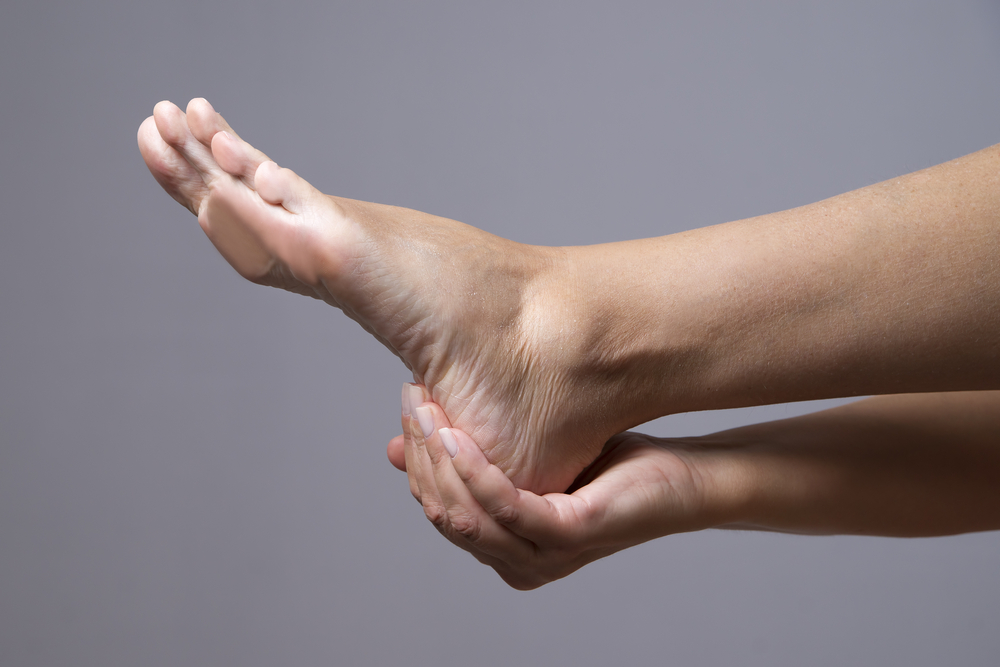 Do you feel pain, weakness, tingling, or burning sensations in your hands or feet? If so, you may have developed peripheral neuropathy. Peripheral neuropathy is a condition in which the nerves of the peripheral nervous system become damaged. The peripheral nervous system is responsible for sending signals from the brain and spinal cord to the rest of the body. When nerves in this system are damaged you may experience symptoms such as pain, weakness, tingling, numbness, and reduced sensation especially in the lower limbs. One of the most common causes of peripheral neuropathy is poorly controlled diabetes. However, there are many other potential causes, such as vitamin deficiencies, excessive alcohol consumption, kidney failure, and shingles. If you are experiencing any symptoms of peripheral neuropathy, is it recommended that you consult with a chiropodist.
Do you feel pain, weakness, tingling, or burning sensations in your hands or feet? If so, you may have developed peripheral neuropathy. Peripheral neuropathy is a condition in which the nerves of the peripheral nervous system become damaged. The peripheral nervous system is responsible for sending signals from the brain and spinal cord to the rest of the body. When nerves in this system are damaged you may experience symptoms such as pain, weakness, tingling, numbness, and reduced sensation especially in the lower limbs. One of the most common causes of peripheral neuropathy is poorly controlled diabetes. However, there are many other potential causes, such as vitamin deficiencies, excessive alcohol consumption, kidney failure, and shingles. If you are experiencing any symptoms of peripheral neuropathy, is it recommended that you consult with a chiropodist.
Neuropathy can cause permanent nerve damage if left untreated. If you are experiencing the symptoms of peripheral neuropathy, please consult with one of our chiropodists of The Footcare Centre. Our chiropodists will assess your condition and provide you with quality foot and ankle treatment.
What Is Peripheral Neuropathy?
Peripheral neuropathy is a condition that damages the nerves of the peripheral nervous system, which provide sensation to the limbs. The feet are often affected. Peripheral neuropathy can have many different causes, but it is most commonly associated with diabetes.
Symptoms
Common symptoms of peripheral neuropathy include:
- Pain
- Numbness or tingling sensation
- Burning sensations
- Weakness
- Loss of balance
Diagnosis
Peripheral neuropathy is diagnosed based on medical history and physical examination. Various tests performed during physical examinations can help determine the type of peripheral neuropathy you may have and what is causing it.
Treatment
Treatment for peripheral neuropathy will depend on what is causing it. For example, if your peripheral neuropathy is caused by diabetes, then managing your blood sugar, exercising regularly to strengthen the legs and feet, and taking pain medications may be recommended as treatments.
If you have any questions please feel free to contact our office located in Niagara Falls, ON. We offer the newest diagnostic tools and technology to treat your foot and ankle needs.
What Is Peripheral Artery Disease?
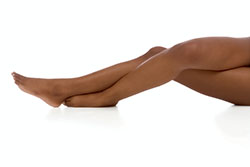 Peripheral artery disease, also known as PAD, is a condition in which the arteries that supply blood to your arms and legs narrow and harden due to a buildup of fatty deposits. This causes a reduction of blood flow, most commonly in the legs. If the blocked blood flow is severe enough it could lead to tissue death, which could ultimately lead to foot or leg amputation. Some symptoms of PAD may include pain, numbness, or heaviness in the legs especially when walking or standing, weak or absent pulses in the legs or feet, poorly healing sores or wounds on the feet, skin discoloration, a lower temperature in one leg, and poor nail growth on the toes, and decreased hair growth on the legs. However, people who have PAD often do not represent any symptoms, and the condition becomes apparent only through physical examination and imaging studies performed by your doctors. Contributing risk factors for PAD can include smoking, obesity, physical inactivity, and a diet that is high in fats or cholesterol. For more information about PAD and its effects on the health of your lower limbs, please speak with a local chiropodist.
Peripheral artery disease, also known as PAD, is a condition in which the arteries that supply blood to your arms and legs narrow and harden due to a buildup of fatty deposits. This causes a reduction of blood flow, most commonly in the legs. If the blocked blood flow is severe enough it could lead to tissue death, which could ultimately lead to foot or leg amputation. Some symptoms of PAD may include pain, numbness, or heaviness in the legs especially when walking or standing, weak or absent pulses in the legs or feet, poorly healing sores or wounds on the feet, skin discoloration, a lower temperature in one leg, and poor nail growth on the toes, and decreased hair growth on the legs. However, people who have PAD often do not represent any symptoms, and the condition becomes apparent only through physical examination and imaging studies performed by your doctors. Contributing risk factors for PAD can include smoking, obesity, physical inactivity, and a diet that is high in fats or cholesterol. For more information about PAD and its effects on the health of your lower limbs, please speak with a local chiropodist.
Peripheral artery disease (PAD) is a serious condition that can increase your risk of having a stroke or heart attack. If you have symptoms of PAD, please consult with one of our chiropodists of The Footcare Centre. Our chiropodists will assess your condition and provide you with quality foot and ankle treatment.
What Is Peripheral Artery Disease?
Peripheral artery disease (PAD) is a condition in which the arteries that supply blood to the lower limbs narrow and harden due to a buildup of arterial plaque. PAD causes a reduction in blood flow to the legs and other extremities.
Symptoms
Often, people with PAD experience no symptoms, especially in the early stages. If PAD continues to worsen, the first sign of PAD may be claudication, a pain and cramping in the legs while walking, caused by the reduction of blood supply to the muscles of the legs.
Other potential symptoms include:
- Numbness or weakness in the legs
- Coldness in the legs or feet
- Slow-healing sores or wounds
- Skin discoloration or hair loss on the legs
- Slow growth of toenails
Diagnosis
Most often chiropodists utilize a test called an ankle-brachial index (ABI). An ABI test compares blood pressure in your arm to the blood pressure in your ankle to see if any abnormality occurs. Vascular tests look at the blood flow in the legs and are generally painless and non-invasive.
Treatment
Lifestyle changes, such as eating a healthy diet and exercising regularly can help limit further arterial plaque buildup. Taking your prescribed medications can reduce your risk of stroke and heart attack. In some cases, surgery may be required to improve blood flow.
If you have any questions please feel free to contact our office located in Niagara Falls, ON. We offer the newest diagnostic tools and technology to treat your foot and ankle needs.
Poor Wound Healing and Diabetes
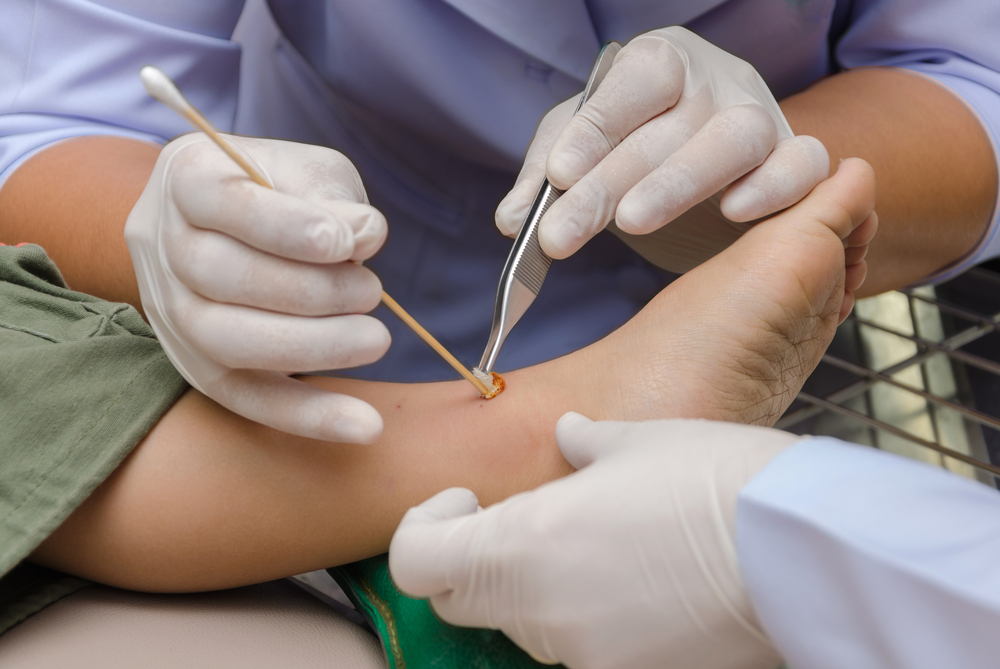 Poor wound healing, especially on the feet, is a common complication of diabetes. The decreased sensation in the lower limbs that often accompanies diabetes, called peripheral neuropathy, can make it difficult to detect cuts, scrapes, and sores on the bottom of the feet. Poor circulation, another condition associated with diabetes, can cause wounds to heal very slowly. Left unnoticed and untreated, wounds on the bottom of the feet can become infected. If you have diabetes it is important to take steps to prevent wounds, and to practice proper wound care should one develop. Wounds may be prevented by properly managing your blood glucose levels, washing and drying the feet thoroughly, wearing comfortable supportive shoes, and performing daily foot inspections to look for any cuts or sores. If you find a wound treat it promptly by cleaning the wound and covering it with a bandage. If a foot wound is healing poorly or showing signs of infection, it is strongly recommended that you find a chiropodist who can help take care of your feet.
Poor wound healing, especially on the feet, is a common complication of diabetes. The decreased sensation in the lower limbs that often accompanies diabetes, called peripheral neuropathy, can make it difficult to detect cuts, scrapes, and sores on the bottom of the feet. Poor circulation, another condition associated with diabetes, can cause wounds to heal very slowly. Left unnoticed and untreated, wounds on the bottom of the feet can become infected. If you have diabetes it is important to take steps to prevent wounds, and to practice proper wound care should one develop. Wounds may be prevented by properly managing your blood glucose levels, washing and drying the feet thoroughly, wearing comfortable supportive shoes, and performing daily foot inspections to look for any cuts or sores. If you find a wound treat it promptly by cleaning the wound and covering it with a bandage. If a foot wound is healing poorly or showing signs of infection, it is strongly recommended that you find a chiropodist who can help take care of your feet.
Wound care is the process of treating and preventing wounds on the feet. This is especially important if you have diabetes, as diabetic foot wounds are common and can lead to serious complications when left untreated. To learn more about proper wound care, please consult with one of our chiropodists of The Footcare Centre. Our chiropodists will assess your condition and provide you with quality foot and ankle treatment.
Why Is Wound Care Important for Diabetics?
While wound care is important for maintaining the health of your feet, it is especially important for people with diabetes. This is because diabetics often suffer from poor blood circulation, causing foot wounds to heal very slowly or not to heal at all. Diabetics also frequently suffer from neuropathy, or nerve loss. This means no matter how big or little the wound, they might not feel it on their foot. If the wound becomes severely infected, amputation may be necessary. This is why it is imperative that diabetics complete daily foot checks.
Wound Care Basics
The best way to care for wounds is to prevent them in the first place. It is recommended that people with diabetes perform a daily examination of their feet to locate cuts, scrapes, sores, or wounds. Early detection allows for ample time to treat the wounds and prevent further complications. If you notice a wound at home, you can clean it using water, apply an antibiotic ointment, and cover the wound with a clean bandage. Seeing a chiropodist, who can examine your feet thoroughly and treat any existing wounds, can also help you maintain proper foot health.
If you have any questions please feel free to contact our office located in Niagara Falls, ON. We offer the newest diagnostic tools and technology to treat your foot and ankle needs.
Why Is Exercising the Feet Important?
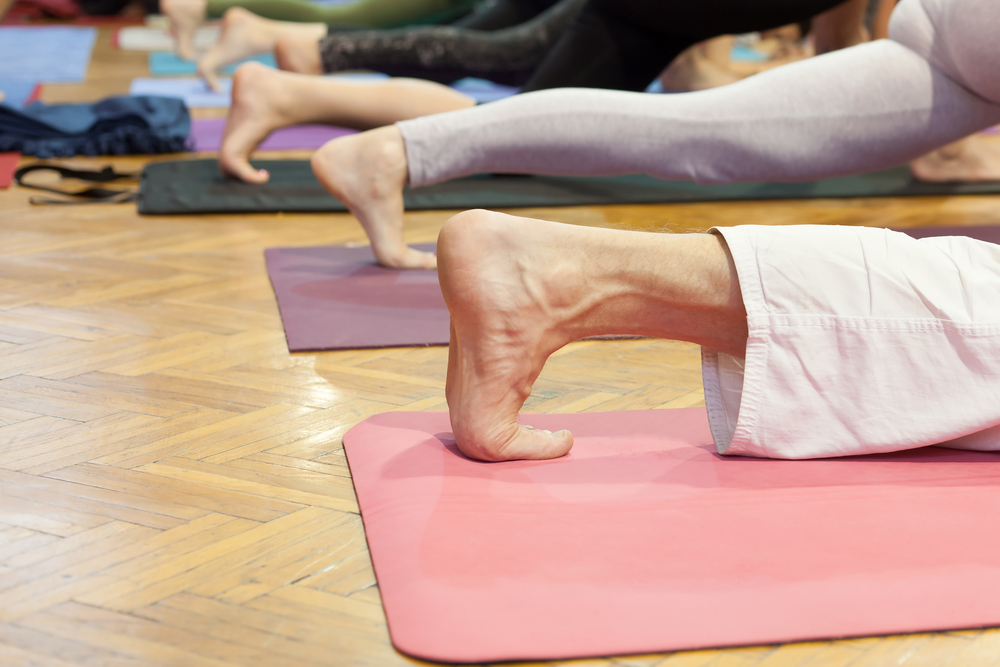 They say the feet are the foundation of our bodies, but how often do you stretch your feet? Having strong and flexible feet can help reduce muscle soreness as well as foot and ankle pain. Performing gentle stretches regularly can also help keep the feet limber and improve their range of motion. There are various types of foot exercises that you can perform to strengthen different parts of the foot. Toe curls for example, strengthen the muscles on the top of the foot and toes. To perform toe curls, lay a towel on the floor and sit down in a chair placing your feet flat on the towel. Scrunch your toes to pull the towel towards you and repeat five times with each foot. It is important to stay active and maintain the overall health of the feet. For additional exercises that can help stretch and strengthen your feet, consult with a chiropodist today.
They say the feet are the foundation of our bodies, but how often do you stretch your feet? Having strong and flexible feet can help reduce muscle soreness as well as foot and ankle pain. Performing gentle stretches regularly can also help keep the feet limber and improve their range of motion. There are various types of foot exercises that you can perform to strengthen different parts of the foot. Toe curls for example, strengthen the muscles on the top of the foot and toes. To perform toe curls, lay a towel on the floor and sit down in a chair placing your feet flat on the towel. Scrunch your toes to pull the towel towards you and repeat five times with each foot. It is important to stay active and maintain the overall health of the feet. For additional exercises that can help stretch and strengthen your feet, consult with a chiropodist today.
Stretching the feet can improve their flexibility and overall strength, and can help prevent or reduce the impact of foot injuries. For more information about stretching your feet, please consult with one of our chiropodists of The Footcare Centre. Our chiropodists will assess your condition and provide you with quality foot and ankle treatment.
Why Stretching the Feet Is Important
Your feet support the weight of your entire body as you go about your daily activities. As with any other part of your body, stretching and exercising the feet can help maintain their overall health, reduce foot pain, and prevent future injuries.
How to Stretch
There are a variety of foot stretches and exercises that you may try. It is recommended that you speak with a chiropodist to learn which exercises are best for you.
Some examples include:
- Heel Raises - hold onto a wall to balance as you slowly rise up on your tiptoes. Hold the position for several seconds, then lower your feet back to the ground. Repeat 10 times.
- Toe Splay - sit in a chair with your feet flat on the ground. Spread your toes as far apart as you can, holding for several seconds. Repeat 10 times.
- Towel Scrunches - sit in a chair and lay a towel flat on the floor in front of you, placing your foot on top of it. Using only your toes, scrunch up the towel, pulling it towards you. Repeat several times with each foot.
- Plantar Fascia Massage - sit in a chair, place a round or cylindrical object - such as a tennis ball, water bottle, or foam roller under the arch of your foot. Roll the object under your foot for 5 minutes. Repeat on the other foot.
If you have any questions please feel free to contact our office located in Niagara Falls, ON. We offer the newest diagnostic tools and technology to treat your foot and ankle needs.
How to Prevent Running Injuries
Overtraining and overusing the feet are the main causes of common running injuries. A number of these common injuries are caused by overrunning. Runner’s knee is a condition that is characterized by the back of the kneecap beginning to wear away and cause pain in the knee. This frequently occurs due to either a decrease in strength in the quadriceps muscles or ill-fitting shoes that are lacking in proper support for the inside of the forefoot. Strengthening exercises focusing on the quad muscle and sports orthotics are the usual treatments for those suffering from runner’s knee. Prevention of the condition lies in a focus on hip strengthening and quad-strengthening to keep the kneecap aligned. To help learn the best exercise to heal runner’s knee, one can also undergo physical therapy.
One common injury, called iliotibial band syndrome, is often caused by overtraining. This condition occurs when the iliotibial band gets irritated, creating pain and discomfort in the outside knee area. Plantar fasciitis, another common running injury, also occurs as a result of inflammation and irritation. Plantar fasciitis is an inflammation and irritation of the bone in the foot. A large amount of pain is often experienced due to plantar fasciitis. The condition can be caused by a high arch, improper footwear, tight muscles, or flat feet. It can best be avoided by stretching and wearing appropriate footwear that supports the foot.
Another common injury for runners is stress fractures. These injuries occur due to running style, overtraining, or a lack of calcium. Stress fractures most often occur in several locations in runners, including the inner bone of the leg, the thighbone, the bone at the base of the spine and the bones of the toes. Stress fractures are best prevented by wearing proper footwear and by running on flat and hard surfaces; this will absorb some of the shock created during running.
Aside from overtraining, other causes of common running injuries include ill-fitting footwear, a lack of flexibility and strength, and irregular biomechanics. The best way to avoid running injuries is to prevent them from even occurring. Both iliotibial band syndrome and stress fractures are preventable. The first step that should be taken to prevent running injuries is to only wear footwear that fits properly and that is appropriate for whatever activity you are doing. Running shoes are the only protective gear available to runners that can safeguard them from sustaining injuries. Choosing the right pair of shoes is therefore extremely important. While running shoes are an important factor, it is also important to consider other facets of your running routine such as training schedules, flexibility, and strengthening. These elements should be considered and altered according to your running needs to best maximize your run and minimize the possibility of injury. Careful stretching before and after a run should also be considered to help prevent running injuries. Stretching muscles enables greater flexibility and a lesser chance of sustaining injury.
